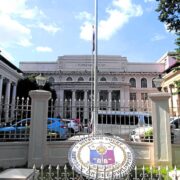Rizal’s hat in Berlin

Next week, the Philippines will be the guest of honor at the Frankfurt Book Fair, the biggest and most important book fair in the world. Jose Rizal is the mascot of the Philippines because of his German connection. He lived in historic Heidelberg to learn German and specialize in eye medicine. He published the ”Noli me Tangere” in Berlin in 1887, at a printing press run by women. Reading Rizal’s letters abroad, one can clearly see the homesickness and longing for the land of his birth, and from this sprang the appreciation of his culture that figured in his ideas of Filipino identity. Rizal was a traveler, not a tourist; he immersed himself in the foreign countries he visited—interacting with people, speaking to them in their languages, and reading their literature and folklore. A pity, really, that Rizal left 25 volumes of writing for a nation that does not read him. Worse, the few who actually read Rizal today do so in translation, because the 21st-century Filipino is separated from Rizal by language, time, and culture.
While learning different European languages—Italian, French, German, and English—he nursed and fiercely protected Tagalog, his mother tongue, by writing home with it, speaking it with other expatriates, and even doing Tagalog translations of tales by Hans Christian Andersen and Schiller’s ”Wilhelm Tell” as a means of unlocking its grammar and syntax and revising its orthography into much of the Filipino we know today. Fearful that years abroad might lead to forgetting his own language, Rizal brought a copy of ”Florante at Laura,” drawing both research and enjoyment from it. Nostalgic references to sinigang, tinola, pancit, burong mangga, and adobo pepper his correspondence as well as his novels.
Mistaken for a Chinese or Japanese in his travels, he lamented that nobody knew where the Philippines was, making him resolve to make it better known abroad. The Rizal textiles in Berlin were an attempt to make the Philippines and the Filipinos better known abroad. In the course of two European sojourns, Rizal perceived Spain less and less as the “mother country” and identified the Philippines more and more as the land of his birth. In time, he recognized the Philippines as his patria, his motherland, and imagined the Filipino nation before it came to be. I will be busy in Frankfurt next week and will have no time for a side trip to Berlin to see the collection of Philippine textiles and artifacts that Rizal donated in 1887. I learned about this collection in 1998, after a special screening of Marilou Diaz Abaya’s film ”Jose Rizal.” After the film, I thought Abaya would ask for my opinion, but instead she advised me to look up the Rizal collection in Berlin. She described what she saw in great detail. For example, a complete woman’s ensemble: a jusi blouse with silk stripes, a pañuelo or large scarf of nipis, a veil, a dark silk tapis, and a pink skirt with brown sinamay or abaca lining. So impressed was Abaya with the high quality of the fabric and workmanship that she concluded, with a knowing smile, that the good taste that went into choosing these could not have been made by a straight man. The suggestion that Rizal was gay or one of the earliest Filipino metrosexuals is left to further research and analysis. My reaction was that these clothes could have been sourced and chosen by Rizal’s mother or any of his nine sisters. Saturnina, the eldest, and the two younger spinster sisters, Trinidad and Josefa, operated a textile store in prewar Manila. Rizal’s sisters must have sourced the Luzon items either from their own Sunday best or their suppliers.
The Berlin Rizal collection has eluded researchers for a long time because of the more documented collection of natural history specimens and a handful of ethnographic items in the Dresden Museum. Rizal sent these through Dr. Adolphe Bernhard Meyer, whom Rizal met in 1886, and was in active correspondence with when the hero was in Europe and even during his exile in Dapitan from 1892 to 1896. Most of the Rizal collection in Dresden awaits further research, because, aside from a monograph on the shells he collected in Dapitan, we only know about: a winged lizard (Draco rizali), a frog (Rhacophorus rizali), and a beetle (Apogonia rizali), whose scientific names reference the collector who sent them to Europe for classification. A few objects in the ethnology section include: four wooden spoons with anthropomorphic figures from the Cordilleras, a barong or cutlass with its wooden sheath, and a brass betel nut presentation tray from Mindanao. The Rizal Collection in Dresden, based on Rizal’s correspondence with Meyer, was sent in the 1890s in exchange for books that provided company and consolation to the hero during his banishment in an obscure town in Zamboanga del Norte.
Of all the objects in the Berlin collection, the most significant is a salakot of horn and silver that was Rizal’s own. I will write about these collections sometime in the future, as there have been discussions regarding a homecoming exhibit, first at the Ayala Museum, and now at the National Museum.
—————-
Comments are welcome at ambeth.ocampo@inquirer.net
Ambeth is a Public Historian whose research covers 19th century Philippines: its art, culture, and the people who figure in the birth of the nation. Professor and former Chair, Department of History, Ateneo de Manila University, he writes a widely-read editorial page column for the Philippine Daily Inquirer, and has published over 30 books—the most recent being: Martial Law: Looking Back 15 (Anvil, 2021) and Yaman: History and Heritage in Philippine Money (Bangko Sentral ng Pilipinas, 2021).


















Drawing the line between influencers and journalists